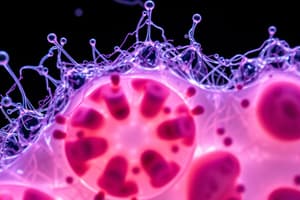Podcast
Questions and Answers
من هو العالم المعروف بأنه 'أب علم التشريح الحديث'؟
من هو العالم المعروف بأنه 'أب علم التشريح الحديث'؟
- فيساليه (correct)
- ويلم هارفي
- جالين
- مارسيلو مالبيغي
ما هي المساهمة الرئيسية لجيمس واتسون وفرانسيس كريك؟
ما هي المساهمة الرئيسية لجيمس واتسون وفرانسيس كريك؟
- وصف الدورة الدموية
- نموذج الدنا اللولبي المزدوج (correct)
- اكتشاف الكريات الدم الحمراء
- تصنيف الكائنات الحية
أي من المفكرين وضع نظام التسمية الثنائي للكائنات الحية؟
أي من المفكرين وضع نظام التسمية الثنائي للكائنات الحية؟
- أرسطو
- كارولوس لينيوس (correct)
- أنتون فان ليفنهوك
- غريغور مندل
من هو العالم الذي اكتشف أن القلب يضخ الدم؟
من هو العالم الذي اكتشف أن القلب يضخ الدم؟
من هو مؤسس علم الوراثة؟
من هو مؤسس علم الوراثة؟
ما هي الخاصية من خصائص الحياة التي تشير إلى زيادة في حجم الخلايا أو عددها؟
ما هي الخاصية من خصائص الحياة التي تشير إلى زيادة في حجم الخلايا أو عددها؟
أي من الخيارات التالية يمثل نوعًا من الحركة الداخلية في الكائنات الحية؟
أي من الخيارات التالية يمثل نوعًا من الحركة الداخلية في الكائنات الحية؟
ما هو المصطلح الذي يشير إلى التوازن في الحالة الداخلية للخلية؟
ما هو المصطلح الذي يشير إلى التوازن في الحالة الداخلية للخلية؟
من هو العالم الذي قام بتحسين تصميم الميكروسكوب واكتشف الخلية لأول مرة؟
من هو العالم الذي قام بتحسين تصميم الميكروسكوب واكتشف الخلية لأول مرة؟
ما هو نوع التكاثر الذي يتضمن اندماج خلايا الجنس؟
ما هو نوع التكاثر الذي يتضمن اندماج خلايا الجنس؟
Flashcards
علم الأحياء
علم الأحياء
دراسة الكائنات الحية، وتشمل تركيبها، وظائفها، وتطورها، وتوزيعها.
أرسطو
أرسطو
فيلسوف يوناني قام بتصنيف الكائنات الحية لأول مرة.
الجالين
الجالين
طبيب يوناني وصف تشريح الجسم البشري اعتمادًا على تشريح القرود والخنازير.
فيساليس
فيساليس
Signup and view all the flashcards
ويليام هارفي
ويليام هارفي
Signup and view all the flashcards
وحدة التركيب والوظيفة في الكائنات الحية
وحدة التركيب والوظيفة في الكائنات الحية
Signup and view all the flashcards
خصائص الكائنات الحية
خصائص الكائنات الحية
Signup and view all the flashcards
التكاثر اللاجنسي
التكاثر اللاجنسي
Signup and view all the flashcards
التكيف
التكيف
Signup and view all the flashcards
الاستقرار
الاستقرار
Signup and view all the flashcards
Study Notes
Introduction to Biology
- Biology is the study of living organisms, encompassing their morphology, anatomy, behavior, origin, and distribution.
- It originates from Greek words: "Bios" (life) and "Logos" (study).
History of Biology
- Aristotle (384-322 BCE): A famous Greek philosopher who pioneered zoology and classified living things. He divided plants into herbs, shrubs, and trees, and animals into land, water, and air dwellers.
- Galen (AD 131-200): A Greek physician who described human anatomy through animal dissections (apes and pigs). He noted arteries carried blood, but his work contained inaccuracies, unchallenged for 1300 years.
- Versalius (1514-1564): The "Father of Modern Anatomy," conducted the first human dissections to study anatomy.
- William Harvey (1578-1657): An English physician who demonstrated the circulation of blood through the body, linking structure and function.
- Marcello Malpighi (1628-1694): An Italian physician who was a microscopist. He discovered capillaries in 1661. He also discovered red blood cells.
Cell Theory
- Microscopes revolutionized the study of cells.
- Robert Hooke (mid-1600s): Used a microscope to observe cork, remarking on the "cells" he saw, like compartments in a monastery.
- Antonie van Leeuwenhoek (1632-1694): Improved microscopy and observed microorganisms, sperm, and single-celled organisms.
- Schwann and Schleiden: Key scientists who proposed fundamental cell theory principles that cells were the basic units of structure and function in living things.
Cell Types: Prokaryotic and Eukaryotic
- Prokaryotic cells: Lack membrane-bound organelles (like bacteria).
- Eukaryotic cells: Contain membrane-bound organelles (like animal and plant cells).
- Both types share common features, such as a plasma membrane, cytosol, chromosomes, and ribosomes.
Similarities and Differences
- Similarities: Both cell types are surrounded by a plasma membrane, contain cytosol, chromosomes, and ribosomes.
- Differences: Eukaryotic cells have a nucleus and membrane-bound organelles while prokaryotes lack a nucleus and membrane bound organelles.
Cell Division
- Eukaryotic cells reproduce via mitosis (for somatic cells) and meiosis (for gamete production).
- Prokaryotic cells reproduce via binary fission, a simpler process.
Additional Properties of Life
- Adaptation: Adjusting to meet the environment's needs
- Metabolism: Set of chemical reactions converting food into energy.
- Specific organization: Different cell parts performing specific functions (e.g., heart, nucleus).
- Homeostasis: Maintaining a stable internal state (e.g., water balance).
- Responsiveness: Reacting to stimuli (e.g., light, temperature).
Animal vs. Plant Cells
- Similarities: Both have a nucleus, mitochondria, cytoplasm, and Golgi apparatus.
- Differences: Plant cells have a cell wall, chloroplasts (for photosynthesis), and a large central vacuole, animal cells mostly don't.
Studying That Suits You
Use AI to generate personalized quizzes and flashcards to suit your learning preferences.




